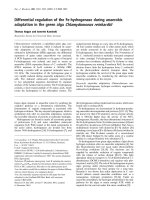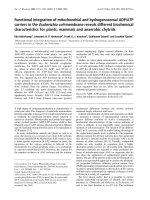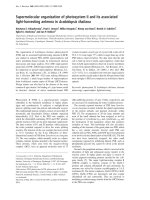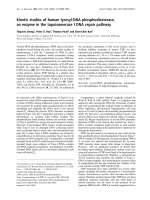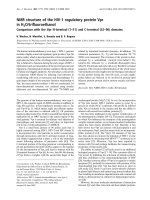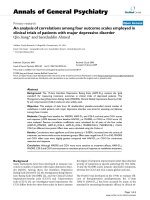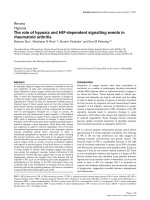Báo cáo y học: "Analog peptides of type II collagen can suppress arthritis in HLA-DR4" docx
Bạn đang xem bản rút gọn của tài liệu. Xem và tải ngay bản đầy đủ của tài liệu tại đây (246.38 KB, 7 trang )
Open Access
Available online />Page 1 of 7
(page number not for citation purposes)
Vol 8 No 5
Research article
Analog peptides of type II collagen can suppress arthritis in
HLA-DR4 (DRB1*0401) transgenic mice
Yoshihiko Sakurai
1,2
, David D Brand
3
, Bo Tang
1
, Edward F Rosloniec
3
, John M Stuart
3
,
Andrew H Kang
1,3
and Linda K Myers
4
1
Department of Medicine, University of Tennessee, 956 Court Avenue, Memphis, TN 38163, USA
2
Current address: Department of Surgery, National Hospital Organization, Kanagawa Hospital, 666-1 Ochiai, Hadano-city, Kanagawa 257-8585,
Japan
3
Research Service, Veterans Affairs Medical Center, 1030 Jefferson Ave., Memphis TN 38104, USA
4
Department of Pediatrics, University of Tennessee, 956 Court Avenue, Memphis, TN 38163, USA
Corresponding author: Linda K Myers,
Received: 14 Aug 2006 Accepted: 18 Sep 2006 Published: 18 Sep 2006
Arthritis Research & Therapy 2006, 8:R150 (doi:10.1186/ar2043)
This article is online at: />© 2006 Sakurai et al.; licensee BioMed Central Ltd.
This is an open access article distributed under the terms of the Creative Commons Attribution License ( />),
which permits unrestricted use, distribution, and reproduction in any medium, provided the original work is properly cited.
Abstract
Rheumatoid arthritis (RA) is an autoimmune disease associated
with the recognition of self proteins secluded in diarthrodial
joints. We have previously established that mice transgenic for
the human DR genes associated with RA are susceptible to
collagen-induced arthritis (CIA) and we have identified a
determinant of type II collagen (CII
263–270
) that triggers T-cell
immune responses in these mice. We have also determined that
an analog of CII
263–270
would suppress disease in DR1
transgenic mice. Because the immunodominant determinant is
the same for both DR1 transgenic and DR4 transgenic mice, we
attempted to determine whether the analog peptide that was
suppressive in DR1 transgenic mice would also be effective in
suppressing CIA in DR4 transgenic mice. We treated DR4
transgenic mice with two analog peptides of CII that contained
substitutions in the core of the immunodominant determinant:
CII
256–276
(F263N, E266D) and CII
256–270
(F263N, E266A).
Mice were observed for CIA, and T-cell proliferative responses
were determined. Either peptide administered at the time of
immunization with CII significantly downregulated arthritis.
Binding studies demonstrated that replacement of the
phenylalanine residue in position 263 of the CII peptide with
asparagine significantly decreased the affinity of the peptide for
the DR4 molecule. In contrast, replacement of the glutamic acid
residue in position 266 with aspartic acid or with alanine had
differing results. Aspartic acid reduced the affinity (35-fold)
whereas alanine did not. Both peptides were capable of
suppressing CIA. With the use of either peptide, CII
256–276
(F263N, E266D) or CII
256–270
(F263N, E266A), the modulation
of CIA was associated with an increase in T-cell secretion of IL-
4 together with a decrease in IFN-γ. We have identified two
analog peptides that are potent suppressors of CIA in DR4
transgenic mice. These experiments represent the first
description of an analog peptide of CII recognized by T cells in
the context of HLA-DR4 that can suppress autoimmune arthritis.
Introduction
Susceptibility to rheumatoid arthritis (RA) is strongly associ-
ated with the expression of specific HLA class II alleles, espe-
cially HLA-DR1 and DR4 [1,2]. It is now known that in most
instances this increased susceptibility is associated with the
DRB1 locus, and specifically with the presence of
DRB1*0101, DRB1*0401, DRB1*0404 or DRB1*0405 allo-
types [3]. Type II collagen (CII) has received considerable
attention as a candidate autoantigen because it is the predom-
inant protein of articular cartilage, and autoimmunity to CII is
commonly detected in patients with RA [4-8]. In support of the
role of autoimmunity to CII in RA, we have shown that mice
transgenic for the HLA-DR1 (DRB1*0101) or DR4
(DRB1*0401) genes develop collagen-induced arthritis (CIA)
after immunization with human CII [9,10]. These data are sig-
nificant in that they demonstrate a direct link between RA sus-
ceptibility alleles and the autoimmunity to CII observed in RA.
Using T cells from the transgenic mice, we have identified
CII
263–270
(FKGEQGPK) as the core of the immunodominant
T-cell determinant presented by both HLA-DR1 (DRB1*0101)
BSA = bovine serum albumin; CFA = complete Freund's adjuvant; CIA = collagen-induced arthritis; CII = type II collagen; IC
50
= 50% inhibitory con-
centration; IFN = interferon; IL = interleukin; MHC = major histocompatibility complex; OcG = octyl glucoside; RA = rheumatoid arthritis.
Arthritis Research & Therapy Vol 8 No 5 Sakurai et al.
Page 2 of 7
(page number not for citation purposes)
and DR4 (DRB1*0401) [11]. Previously, we identified a syn-
thetic analog peptide of human CII, CII
256–276
(F263N,
E266D), also called A12, which could profoundly suppress
arthritis when administered to DR1 transgenic mice [12]. Con-
sidering that both DR1 and DR4 transgenic mice react with a
common core epitope, it was of interest to determine whether
the analog peptide A12 could also suppress arthritis in the
context of DRB1*0401. For these experiments we used a
panel of analog peptides of the immunodominant determinant
of CII and were able to identify two analog peptides that sup-
press arthritis in DR4 mice. These peptides included A12 and
CII
256–276
(F263N, E266A), also called A13. To clarify the
structural characteristics of the DR4-peptide complexes, we
analyzed the DR4-restricted presentation of analogs of the
CII
256–276
peptide with the use of peptide binding assays.
These studies reveal that residues 263 and 266 are crucial for
interaction with the DR4 molecule. With either A12 or A13,
the modulation of CIA was associated with an increase in T-
cell secretion of the T helper type 2 cytokine IL-4 together with
a decrease in the T helper type 1 cytokine IFN-γ. These exper-
iments represent the first description of analog peptides of
type II collagen recognized by T cells in the context of the
human DR4 molecule that can suppress autoimmune arthritis.
Materials and methods
Animals
B10.M-DR4
+/-
transgenic mice were raised in our animal facil-
ity in a specific pathogen-free environment. The DR4 trans-
gene was constructed as a chimeric molecule composed of
DR4 α1 and β1 domains and I-Eα2 and β2 domains. The pro-
duction of the chimeric genes and the B10.M-DR4 transgenic
mouse has been described previously [13]. The B10.M-DR4
mice were maintained as heterozygotes for the DR4 trans-
gene, because homozygous B10.M-DR4 mice from this
founder do not survive.
Immunization
CII was dissolved in 0.01 M acetic acid and emulsified with an
equal volume of complete Freund's adjuvant (CFA) as
described previously [14]. The resulting emulsion was injected
subcutaneously into the base of the tail. Each mouse received
a total volume of 0.05 ml containing 100 µg of Mycobacterium
tuberculosis and 100 µg of antigen. All work was approved by
the Institutional Animal Care and Use Committee.
Preparation of CII
Native CII was solubilized from bovine articular cartilage by
limited pepsin digestion and purified as described previously
[14].
Synthesis of analog peptides of CII
The peptide representing the immunodominant determinant of
CII and its analog peptides containing specific amino acid
substitutions were chemically synthesized by a solid-phase
procedure described previously, using a model 430 peptide
synthesizer (Applied Biosystems, Foster City, CA, USA) and
purified by high-performance liquid chromatography [14].
Measurement of T-cell cytokines by ELISA
Quantitative measurement of cytokines was performed as
described previously [12]. In brief, spleens and lymph nodes
from DR4 mice immunized with bovine CII (or CII plus other
peptides) emulsified with CFA 10 to 14 days previously were
individually minced into single-cell suspensions in Hanks bal-
anced salt solution (HBSS) and washed three times with
HBSS. Pooled splenocytes and lymph-node cells were then
adjusted to a concentration of 5 × 10
6
/ml and cultured with
100 µg/ml antigen in Dulbecco's modified Eagle's medium
(Gibco, Grand Island, NY, USA) supplemented with 5% fetal
bovine serum (Hyclone, Logan, UT, USA). Supernatants were
collected 72 to 120 hours later and used either fresh or frozen
at -70°C. Commercially available kits for IFN-γ (Gibco BRL,
Gaithersburg, MD, USA), IL-4 and IL-10 (Endogen, Cam-
bridge, MA, USA) were used for quantitative measurement of
murine cytokines.
Proliferation assays
Mice were immunized subcutaneously with 100 µg of type II
collagen emulsified in an equal volume of CFA. Ten days after
immunization, draining lymph nodes were removed, disassoci-
ated, and washed in HL-1 medium (Bio-Whitaker, Walkers-
ville, MD, USA). Lymphocytes were cultured at 37°C for 4
days with various collagen peptides in 96-well plates at 4.5 ×
10
5
per well in 300 µl of HL-1 medium supplemented with 50
µM 2-mercaptoethanol and 0.1% BSA in 5% humidified CO
2
.
Eighteen hours before the termination of the cultures, 1 µCi of
[
3
H]thymidine (New England Nuclear, Boston, MA, USA) was
added to each well. Cells were harvested onto glass fiber fil-
ters and were counted on a Matrix 96 direct ionization β-coun-
ter (Packard Instrument Company, Meriden, CT, USA).
Purification of DR molecules
Soluble DR1 and DR4 were purified from culture supernatants
of transfected S2 Drosophila cells as described previously
[11]. In brief, the cytoplasmic and transmembrane portions of
these molecules were deleted from the cDNA by polymerase
chain reaction, a new stop codon was inserted immediately
before the transmembrane domain, and the resulting cDNA
was cloned into the Drosophila expression vector pRmHA-3.
S2 cells were transfected with a 10:1 ratio of DRB1 and
DRA1 to pUChsneo by precipitation with calcium phosphate.
Soluble DR production was induced by 1 mM CuSO
4
, and 5
days later the culture supernatant was collected and adjusted
to 0.05% octyl glucoside (OcG). The soluble DR was purified
by passage of the supernatant over an affinity column coupled
with the anti-DR antibody LB 3.1. The column was washed
with 0.05% OcG and 0.15 M NaCl in phosphate buffer, pH
7.5, followed by 0.05% OcG and 0.5 M NaCl in phosphate
buffer, pH 7.5. The DR was eluted with 100 mM Tris-HCl, 0.5
M NaCl, pH 11.2, and the fractions were immediately
Available online />Page 3 of 7
(page number not for citation purposes)
neutralized with acetic acid. The recovered DR was concen-
trated with an Amicon Stirred Cell (Beverly, MA, USA) and
quantified by measurement of A
280
and subjection to SDS-
PAGE before use.
Class II binding assays
Class II binding assays were performed as described by Hill
and colleagues [15]. In brief, various concentrations of the
competitor peptides were incubated for 4 hours at 37°C, with
constant concentrations of biotinylated hemagglutinin (HA)
(307–319) peptide (0.5 nM for DR1, 5 nM for DR4) and DR
molecule (10 nM) in PBS containing OcG. After incubation,
DR-peptide complexes were transferred and captured by incu-
bation overnight at 4°C on a 96-well microtiter plate initially
coated with LB3.1 (anti-DR) and blocked with BSA. Excess
peptide was removed by washing with PBS containing 0.05%
Tween 20. The plates were treated with europium-labeled
streptavidin (DELFIA) and incubated for 2 hours at 25°C. After
being washed, the plates were treated with a chelating
enhancement solution (DELFIA), which releases europium
from streptavidin and forms a highly fluorescent micellar solu-
tion. Fluorescence was quantified with a microplate fluorimeter
(DELFIA; LKB/Pharmacia, Uppsala, Sweden). The concentra-
tion of CII peptide inhibiting 50% of the binding of HA peptide
(IC
50
) was calculated from the linear portion of the curves. IC
50
values are the average of two determinations per peptide.
Results
T-cell responses to analog peptides
We have previously determined that both DR1 and DR4 mice
are susceptible to CIA and respond to the same core determi-
nants in CII. However, T-cell hybridomas generated from each
strain are restricted by the respective DR molecules. Hybrido-
mas from DR1 mice do not recognize the core determinant
presented by DR4 and vice versa [11].
To select altered peptide ligands that might suppress arthritis,
we used a panel of analog peptides containing substitutions at
each position of the immunodominant DR4-restricted determi-
nant of CII, replacing the wild-type residue with either alanine
or the analogous amino acid present in type I collagen as we
have done previously with DR1 molecules. The peptides were
tested for reaction with T cells from DR4 transgenic mice that
had been immunized with CII. Cells from draining lymph nodes
of DR4 mice immunized with CII were cultured with each pep-
tide, and the proliferative responses were measured with a
[
3
H]thymidine incorporation assay. Variable T-cell responses
were generated against the analog peptides (Figure 1). Sub-
stitutions of alanine for glycine at positions 265 and 268 did
not seem to affect the response appreciably. However, the
weakest responses were generated against peptides contain-
ing substitutions at positions 263 and 266. These results are
comparable to those we have previously shown for DR1 and
suggest that positions 263 and 266 in CII are critical for T-cell
recognition of the peptide in the context of both DR1 and DR4
complexes.
Effects of A12 and A13 on cytokine production by T cells
An important characteristic of an altered peptide ligand is its
ability to alter the cytokine profile of responding T cells. We
therefore determined the cytokine profile induced by analog
peptides containing substitutions at residue 263 or 266 or
both, with emphasis on IFN-γ, IL-10 and IL-4. When T cells
from CII-immunized DR4 mice were cultured in vitro with vari-
ous analog peptides (Table 1), the cytokine response to wild-
type peptide was predominantly IFN-γ and IL-10. In contrast,
analog peptides containing substitutions at residue 263 or
266 had a decreased IFN-γ response. The most effective com-
binations of both decreased IFN-γ and increased IL-4
responses were accomplished in analog peptides containing
substitutions at both residues 263 and 266, namely A12 and
A13. This combination of cytokine secretion could not be
duplicated by low doses of the wild-type peptide. When CII-
specific T cells were cultured with the wild-type peptide at low
doses (10 µg/ml), secretion of IFN-γ was slightly above back-
ground (52 ± 5 pg/ml), whereas that of IL-4 decreased to
undetectable levels.
Secretion of IL-4 is significant because it is effective in sup-
pressing murine inflammatory arthritis [16-19]. Although ana-
log peptides containing individual substitutions of F263N,
E266D, and E266A decreased the IFN-γ response, they did
not induce a significant IL-4 response. The combination of two
Figure 1
Proliferation of DR4-(DRB1*0401)-restricted T cells in response to type II collagenProliferation of DR4-(DRB1*0401)-restricted T cells in response to
type II collagen. A panel of analog peptides containing amino acid sub-
stitutions was tested for the ability to stimulate the proliferation of type II
collagen (CII)-primed T cells. DR4 transgenic mice were immunized
with CII; 10 days later, draining lymph node cells were harvested and
cultured with the analog peptides. Proliferation was measured by
[
3
H]thymidine incorporation and results are shown as means ± stand-
ard deviation (x axis). Data shown are from a representative experiment.
Lymph node cells from six immunized mice were pooled before culture,
and the data were subsequently confirmed in three separate experi-
ments. Control cells cultured with no antigen had a proliferation value
of 0.38 × 10
-3
d.p.m.
Arthritis Research & Therapy Vol 8 No 5 Sakurai et al.
Page 4 of 7
(page number not for citation purposes)
substitutions at both residues 263 and 266 was required to
produce both a decrease in IFN-γ and an increase in IL-4.
In a separate experiment, lymph nodes were taken from mice
previously co-immunized with CII plus A12 or CII plus A13 and
cultured with CII to determine whether the shift toward IL-4
could be confirmed ex vivo. Whereas the IFN-γ responses to
CII were intermediate (425 ± 12 and 348 ± 14 pg/ml, respec-
tively), the IL-4 responses were elevated (52 ± 8 and 49 ± 6
pg/ml, respectively).
Binding of synthesized peptides to human DR4
T cells recognize peptides only if they are bound by major his-
tocompatibility complex (MHC) molecules. Therefore, with the
use of 21-mer synthesized peptides, DR-peptide binding
assays were performed to determine the pattern of collagen
binding to DR4. As shown in Figure 2, replacement of residue
263 with either asparagine or alanine significantly weakened
binding. In contrast, replacement of residue 266 with an
alanine or aspartic acid residue had differing effects. The pep-
tide containing the small nonpolar alanine bound as effectively
to DR4 as the wild-type peptide, whereas aspartic acid at
position 266 caused a decrease in affinity with an IC
50
of
about 1,000. Peptides containing both substitutions, specifi-
cally A12 and A13, had significantly weaker affinities for DR4
than wild-type peptide (with IC
50
values greater than 10,000).
These data imply that competition with the wild-type peptide
for binding to the DR4 is extremely unlikely as an etiology for
the suppression of arthritis induced by A12 and A13. Moreo-
ver, substitutions at residue 266 of CII, which is the residue
that interacts with the MHC shared epitope [20], cause wide
variations in binding affinity.
Effect of analog peptides on collagen-induced arthritis
Because both residues 263 and 266 of CII were identified as
crucial for T-cell responses, analog peptides A12 and A13,
containing substitutions at these two positions, were selected
for testing in autoimmune arthritis in vivo. DR4 transgenic mice
were immunized with CII, CII plus A12, CII plus A13, or CII
plus the control peptide 266D, and were observed for the
development of arthritis. When CII and either A12 or A13 were
used at a molar ratio of 1:480, the development of arthritis was
completely inhibited, whereas the control peptide had no
effect. Concordant with a decrease in the incidence and
severity of arthritis, the production of antibody against CII was
also significantly decreased (Table 2 and Figure 3).
Discussion
We report that A12, an analog peptide of type II collagen, is
effective in suppressing autoimmune arthritis in mice bearing
a transgene for HLA DRB1*0401. The finding that the same
peptide is effective in both HLA DRB1*0401 and HLA
DRB1*0101 is somewhat surprising but not totally unex-
pected because the immunodominant determinant, CII
256–276
,
Table 1
DR4 T-cell response to analog peptides after immunization with type II collagen (CII)
Peptide Sequence
a 263 266
IFN-γ (pg/ml) IL-10 (pg/ml) IL-4 (pg/ml)
Wild type
G-E-B-G-I-A-G-F-K-G-E-Q-G-P-K-G-E-B-G-P-A
1,575 ± 20 570 ± 8 12 ± 3
A9
- - - - A B - N - - - - - - - - - - - - -
350 ± 11 580 ± 11 33 ± 12
A12
- - - - - - - N - - D - - - - - - - - - -
175 ± 7 610 ± 7 48 ± 15
A13
- - - - - - - N - - A - - - - - - - - - -
<1 575 ± 9 66 ± 10
263N
- - - - - - - N - - - - - - - - - - - - -
263 ± 13 560 ± 13 9 ± 9
266A
- - - - - - - - - - A - - - - - - - - - -
<1 590 ± 10 6 ± 9
266D
- - - - - - - - - - D - - - - - - - - - -
175 ± 6 600 ± 12 9 ± 5
Pooled splenocytes and lymph node cells (5 × 10
6
cells/ml) from DR4 mice immunized with CII 10 to 14 days previously were cultured with 100
µg/ml antigen (synthetic peptides). Each experiment included cells from three mice and was performed three times. Supernatants were collected
and assayed for IFN-γ, IL-4, and IL-10. Values are means ± SD. Numbers in bold type indicate values greater than fivefold those of wild-type
peptide. The cytokine response to wild-type peptide included primarily IFN-γ and IL-10. In contrast, the analog peptides A12 and A13 induced the
production of predominantly IL-4 and IL-10.
Figure 2
Binding of analog peptides to DRB1*0401Binding of analog peptides to DRB1*0401. IC
50
(50% inhibitory con-
centration) values are the average of two determinations per peptide.
Peptides binding to DRB1*0401 with an IC
50
of about 1,000 are repre-
sented by striped bars (264A, 266D). Peptides binding to DRB1*0401
with an IC
50
of 100 or less (comparable to wild-type peptide binding)
are represented by white bars.
Available online />Page 5 of 7
(page number not for citation purposes)
is common to both DR1 and DR4 transgenic mice. In addition
to A12, we identified another altered peptide ligand, A13, con-
taining substitutions within the immunodominant determinant
of type II collagen that effectively suppress autoimmune arthri-
tis in DR4 transgenic mice.
Both of these analog peptides contain substitutions at resi-
dues 263 and 266, which are anchor residues for
DRB1*0401 [11,21-23]. It is evident that there is not a total
absence of binding because both analogs can mediate a T-cell
response, specifically an increased production of IL-4. How-
ever, the weak binding precludes either analog from outcom-
peting the wild-type peptide for binding to the MHC. In
preliminary studies, if peptide A12 and wild-type peptide were
covalently bound to soluble DR4 molecules in the presence of
peptide HA and an HA-specific T hybrid, we found that A12
was more easily displaced than wild-type peptide by the HA,
yet some displacement was required (EF Rosloniec, unpub-
lished work).
The ability of A12 to suppress arthritis is correlated with a
change in the cytokine response that included combinations of
both decreased IFN-γ and increased IL-4 production. This sug-
gests that the basis for suppression is the cytokine shift
responsible for its activity. Interestingly, the individual collagen
substitutions of F
263
→N, E
266
→D, and E
266
→A each
decreased the IFN-γ response but did not induce a significant
IL-4 response. The combination of two substitutions at both
residues 263 and 266 was required to produce both a
decrease in IFN-γ and an increase in IL-4. For DRB1*0401 the
replacement of residue 266 with either D or A was effective,
although the alanine seemed to be slightly more effective. The
similarities between the two cytokine profiles were unex-
pected because the binding affinities vary significantly.
Crystal structure of HLA DRB1*0101 has revealed that the
shared epitope at residues 70–74 forms part of the P4 binding
pocket [20]. Although the shared epitope is similar for DR4
and DR1, DRB1*0101 has an arginine at residue 71, whereas
DRB1*0401 has lysine. Crystal evidence suggests that resi-
due 266 of CII interacts with DRB1 residue 71 [24], possibly
explaining the haplotype differences we find when A13 is used
to suppress arthritis. Although it has previously been thought
that MHC binding was mostly independent of the MHC-pep-
tide surface conformation, new technology with MHC-peptide
tetramers reveals that changes in the residues interacting with
the MHC binding pockets can induce subtle but important
Figure 3
Co-immunization of DR4 transgenic mice with type II collagen and ana-log peptidesCo-immunization of DR4 transgenic mice with type II collagen and ana-
log peptides. Groups of DR4 transgenic mice were co-immunized with
50 µg of type II collagen (CII) alone (n = 18; circles) or with 50 µg of
CII plus 1.2 mg of the analog peptide CI
256–276
, (F263N, E266D) (n =
16; upward triangles), with 50 µg of CII plus 1.2 mg of the analog pep-
tide CII
256–276
(F263N, E266A) (n = 10; downward triangles), or with
50 µg of CII plus 1.2 mg of the analog peptide CII
256–276
(E266D) (n =
10; diamonds) and observed for arthritis. Results are incidences (upper
panel) and mean severity scores (lower panel) of arthritis observed at
various time points after immunization.
Table 2
Co-immunization of DR4 transgenic mice with type II collagen
(CII) and analog peptides
Immunizing antigen Core of co-immunogen Incidence of arthritis CII antibodies
CII alone
FKGEQGPKG
11/18 (61%) 61 ± 11
CII + A13 (1:480)
N A
0/10
a
7 ± 2
b
CII + A12 (1:480)
N D
0/16
b
16 ± 9
b
CII + D266 (1:480)
D
7/10 (70%) 48 ± 13
Groups of DR4 transgenic mice were co-immunized with CII alone or
CII plus an analog peptide at the molar ratios indicated, and were
observed for arthritis. These doses were based on dose-response
curves obtained using DR1 mice [12]. Results shown represent the
incidence of arthritis observed at 8 weeks after immunization. Mice
were bled at 6 weeks after immunization, and sera were analyzed
individually by enzyme-linked immunosorbent assay to determine
antibody levels against bovine CII. Results are means ± SD for each
group of animals and are expressed in units of activity.
a
p ≤ 0.01;
b
p ≤
0.001.
Arthritis Research & Therapy Vol 8 No 5 Sakurai et al.
Page 6 of 7
(page number not for citation purposes)
stereo chemical changes on residues positioned to interact
with the TCR [25,26].
Our findings have implications for the treatment of RA. Sus-
ceptibility to RA is strongly associated with the expression of
specific HLA class II alleles, and DRB1*0401 is the haplotype
most commonly expressed in patients with RA [1,2].
DRB1*0101 is also associated with RA, although it is less
common. T cells from patients with either allele are likely to
have an altered response to A12. Treatment with this single
peptide might therefore be effective for all RA susceptibility
alleles that contain the 'shared epitope'.
Conclusion
We have analyzed the DR-restricted presentation of the
CII
256–276
peptide and identified two analog peptides that sup-
press arthritis in the context of DRB1*0401. These experi-
ments represent the first description of an analog peptide of
type II collagen recognized by T cells in the context of the
human DR4 molecule that can suppress autoimmune arthritis,
and could become the basis for development of new therapies
for RA.
Competing interests
The authors declare that they have no competing interests.
Authors' contributions
YS, DDB and BT performed the experiments in this manu-
script. EFR, JMS, AHK and LKM provided supervision and
experimental design. All authors read and approved the final
manuscript.
Acknowledgements
This work was supported, in part, by USPHS Grants AR-39166, AR-
43589, and AR-45987, and program-directed funds from the Depart-
ment of Veterans Affairs and the Arthritis Foundation.
References
1. Nepom GT, Byers P, Seyfried C, Healey LA, Wilske KR, Stage D,
Nepom BS: HLA genes associated with rheumatoid arthritis.
Identification of susceptibility alleles using specific oligonu-
cleotide probes. Arthritis Rheum 1989, 32:15-21.
2. Stastny P, Ball E, Kahn M, Olsen N, Pincus T, Gao X: HLA-DR4
and other genetic markers in rheumatoid arthritis. Br J
Rheumatol 1988, 27:132-138.
3. Wordsworth BP, Lanchbury JS, Sakkas LI, Welsh KI, Panayi GS,
Bell JI: HLA-DR4 subtype frequencies in rheumatoid arthritis
indicate that DRB1 is the major susceptibility locus within the
HLA class II region. Proc Natl Acad Sci USA 1989,
86:10049-10053.
4. Kim WU, Yoo WH, Park W, Kang YM, Kim SI, Park JH, Lee SS, Joo
YS, Min JK, Hong YS, et al.: IgG antibodies to type II collagen
reflect inflammatory activity in patients with rheumatoid
arthritis. J Rheumatol 2000, 27:575-581.
5. Londei M, Savill CM, Verhoef A, Brennan F, Leech ZA, Duance V,
Maini RN, Feldmann M: Persistence of collagen type II-specific
T cell clones in synovial membrane of a patient with rheuma-
toid arthritis. Proc Natl Acad Sci USA 1989, 86:636-640.
6. Jasin HE: Autoantibody specificities of immune complexes
sequestered in articular cartilage of patients with rheumatoid
arthritis and osteoarthritis. Arthritis Rheum 1985, 28:241-248.
7. Watson WC, Cremer MA, Wooley PH, Townes AS: Assessment
of the potential pathogenicity of type II collagen autoantibod-
ies in patients with rheumatoid arthritis. Arthritis Rheum 1986,
29:1316-1321.
8. Watson WC, Tooms RE, Carnesale PG, Dutkowski JP: A case of
germinal center formation by CD45RO T and CD20 B lym-
phocytes in rheumatoid arthritis subchondral bone: proposal
for a two compartment model of immune-mediated disease
with implications for immunotherapeutic strategies. Clin
Immunol Immunopathol 1994, 73:27-37.
9. Rosloniec EF, Brand DD, Myers LK, Whittington KB,
Gumanovskaya M, Zaller DM, Woods A, Altmann DM, Stuart JM,
Kang AH: An HLA-DR1 transgene confers susceptibility to col-
lagen-induced arthritis elicited with human type II collagen. J
Exp Med 1997, 185:1113-1122.
10. Rosloniec EF, Brand DD, Myers LK, Esaki Y, Whittington KB, Zaller
DM, Woods A, Stuart JM, Kang AH: Induction of autoimmune
arthritis in HLA-DR4 (DRB1*0401) transgenic mice by immuni-
zation with human and bovine type II collagen. J Immunol
1998, 160:2573-2578.
11. Rosloniec EF, Whittington KB, Zaller DM, Kang AH: HLA-DR1
(DRB1*0101) and DR4 (DRB1*0401) use the same anchor res-
idues for binding an immunodominant peptide derived from
human type II collagen. J Immunol 2002, 168:253-259.
12. Myers LK, Sakurai Y, Tang B, He X, Rosloniec EF, Stuart JM, Kang
AH: Peptide-induced suppression of collagen-induced arthri-
tis in HLA-DR1 transgenic mice. Arthritis Rheum 2002,
46:3369-3377.
13. Woods A, Chen HY, Trumbauer ME, Sirotina A, Cummings R, Zal-
ler DM: Human major histocompatibility complex class II-
restricted T cell responses in transgenic mice. J Exp Med
1994, 180:173-181.
14. Rosloniec EF, Kang AH, Myers LK, Cremer MA: Collagen-
induced arthritis. In Current Protocols in Immunology Edited by:
Coico R, Shevach E. New York: Wiley & Sons;
1997:15.15.11-15.15.24.
15. Hill CM, Liu A, Marshall KW, Mayer J, Jorgensen B, Yuan B, Cub-
bon RM, Nichols EA, Wicker LS, Rothbard JB: Exploration of
requirements for peptide binding to HLA DRB1*0101 and
DRB1*0401. J Immunol 1994, 152:2890-2898.
16. Joosten LA, Lubberts E, Helsen MM, Saxne T, Coenen-de Roo CJ,
Heinegard D, van den Berg WB: Protection against cartilage
and bone destruction by systemic interleukin-4 treatment in
established murine type II collagen-induced arthritis. Arthritis
Res 1999, 1:81-91.
17. Kim SH, Kim S, Evans CH, Ghivizzani SC, Oligino T, Robbins PD:
Effective treatment of established murine collagen-induced
arthritis by systemic administration of dendritic cells geneti-
cally modified to express IL-4. J Immunol 2001,
166:3499-3505.
18. Watanabe S, Imagawa T, Boivin GP, Gao G, Wilson JM, Hirsch R:
Adeno-associated virus mediates long-term gene transfer and
delivery of chondroprotective IL-4 to murine synovium. Mol
Ther 2000, 2:147-152.
19. Tanaka Y, Otsuka T, Hotokebuchi T, Miyahara H, Nakashima H,
Kuga S, Nemoto Y, Niiro H, Niho Y: Effect of IL-10 on collagen-
induced arthritis in mice. Inflamm Res 1996, 45:283-288.
20. Stern LJ, Brown JH, Jardetzky TS, Gorga JC, Urban RG,
Strominger JL, Wiley DC: Crystal structure of the human class
II MHC protein HLA-DR1 complexed with an influenza virus
peptide. Nature 1994, 368:215-221.
21. Sette A, Buus S, Colon S, Smith JA, Miles C, Grey HM: Structural
characteristics of an antigen required for its interaction with Ia
and recognition by T cells. Nature 1987, 328:395-399.
22. Sette A, Buus S, Appella E, Smith JA, Chesnut R, Miles C, Colon
SM, Grey HM: Prediction of major histocompatibility complex
binding regions of protein antigens by sequence pattern
analysis. Proc Natl Acad Sci USA 1989, 86:3296-3300.
23. Scott CA, Peterson PA, Teyton L, Wilson IA: Crystal structures of
two I-Ad-peptide complexes reveal that high affinity can be
achieved without large anchor residues. Immunity 1998,
8:319-329.
24. Dessen A, Lawrence CM, Cupo S, Zaller DM, Wiley DC: X-ray
crystal structure of HLA-DR4 (DRA*0101 DRB1*0401) com-
plexed with a peptide from human collagen II. Immunity 1997,
7:473-481.
25. Nepom GT: Tetramer analysis of human autoreactive CD4-
positive T cells. Adv Immunol 2005, 88:51-71.
Available online />Page 7 of 7
(page number not for citation purposes)
26. Mallone R, Kochik SA, Reijonen H, Carson B, Ziegler SF, Kwok
WW, Nepom GT: Functional avidity directs T-cell fate in auto-
reactive CD4
+
T cells. Blood 2005, 106:2798-2805.


